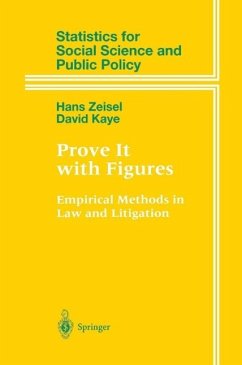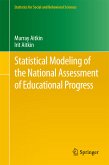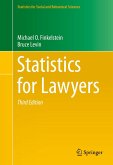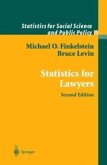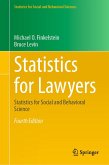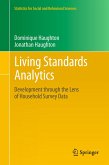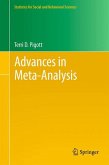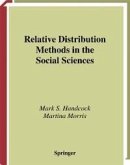40,95 €
40,95 €
inkl. MwSt.
Sofort per Download lieferbar

20 °P sammeln
40,95 €
Als Download kaufen

40,95 €
inkl. MwSt.
Sofort per Download lieferbar

20 °P sammeln
Jetzt verschenken
Alle Infos zum eBook verschenken
40,95 €
inkl. MwSt.
Sofort per Download lieferbar
Alle Infos zum eBook verschenken

20 °P sammeln
- Format: PDF
- Merkliste
- Auf die Merkliste
- Bewerten Bewerten
- Teilen
- Produkt teilen
- Produkterinnerung
- Produkterinnerung

Bitte loggen Sie sich zunächst in Ihr Kundenkonto ein oder registrieren Sie sich bei
bücher.de, um das eBook-Abo tolino select nutzen zu können.
Hier können Sie sich einloggen
Hier können Sie sich einloggen
Sie sind bereits eingeloggt. Klicken Sie auf 2. tolino select Abo, um fortzufahren.

Bitte loggen Sie sich zunächst in Ihr Kundenkonto ein oder registrieren Sie sich bei bücher.de, um das eBook-Abo tolino select nutzen zu können.
This book presents statistical and social science research methods for lawyers and students of the law. Hans Zeisel's studies represent the blending of the best of European and American sociology, psychology, and other social sciences with jurisprudence. David Kaye picks up Zeisel's torch of statistically-based factfindindg, illuminating the latest developments in the field of legal statistics.
- Geräte: PC
- ohne Kopierschutz
- eBook Hilfe
- Größe: 46.21MB
Andere Kunden interessierten sich auch für
![Statistical Modeling of the National Assessment of Educational Progress (eBook, PDF) Statistical Modeling of the National Assessment of Educational Progress (eBook, PDF)]() Murray AitkinStatistical Modeling of the National Assessment of Educational Progress (eBook, PDF)40,95 €
Murray AitkinStatistical Modeling of the National Assessment of Educational Progress (eBook, PDF)40,95 €![Statistics for Lawyers (eBook, PDF) Statistics for Lawyers (eBook, PDF)]() Michael O. FinkelsteinStatistics for Lawyers (eBook, PDF)72,95 €
Michael O. FinkelsteinStatistics for Lawyers (eBook, PDF)72,95 €![Statistics for Lawyers (eBook, PDF) Statistics for Lawyers (eBook, PDF)]() Michael O. FinkelsteinStatistics for Lawyers (eBook, PDF)60,95 €
Michael O. FinkelsteinStatistics for Lawyers (eBook, PDF)60,95 €![Statistics for Lawyers (eBook, PDF) Statistics for Lawyers (eBook, PDF)]() Michael O. FinkelsteinStatistics for Lawyers (eBook, PDF)104,95 €
Michael O. FinkelsteinStatistics for Lawyers (eBook, PDF)104,95 €![Living Standards Analytics (eBook, PDF) Living Standards Analytics (eBook, PDF)]() Dominique HaughtonLiving Standards Analytics (eBook, PDF)40,95 €
Dominique HaughtonLiving Standards Analytics (eBook, PDF)40,95 €![Advances in Meta-Analysis (eBook, PDF) Advances in Meta-Analysis (eBook, PDF)]() Terri PigottAdvances in Meta-Analysis (eBook, PDF)40,95 €
Terri PigottAdvances in Meta-Analysis (eBook, PDF)40,95 €![Relative Distribution Methods in the Social Sciences (eBook, PDF) Relative Distribution Methods in the Social Sciences (eBook, PDF)]() Mark S. HandcockRelative Distribution Methods in the Social Sciences (eBook, PDF)40,95 €
Mark S. HandcockRelative Distribution Methods in the Social Sciences (eBook, PDF)40,95 €-
-
-
This book presents statistical and social science research methods for lawyers and students of the law. Hans Zeisel's studies represent the blending of the best of European and American sociology, psychology, and other social sciences with jurisprudence. David Kaye picks up Zeisel's torch of statistically-based factfindindg, illuminating the latest developments in the field of legal statistics.
Dieser Download kann aus rechtlichen Gründen nur mit Rechnungsadresse in A, B, BG, CY, CZ, D, DK, EW, E, FIN, F, GR, HR, H, IRL, I, LT, L, LR, M, NL, PL, P, R, S, SLO, SK ausgeliefert werden.
Produktdetails
- Produktdetails
- Verlag: Springer US
- Seitenzahl: 353
- Erscheinungstermin: 6. Dezember 2012
- Englisch
- ISBN-13: 9781461218241
- Artikelnr.: 43992058
- Verlag: Springer US
- Seitenzahl: 353
- Erscheinungstermin: 6. Dezember 2012
- Englisch
- ISBN-13: 9781461218241
- Artikelnr.: 43992058
- Herstellerkennzeichnung Die Herstellerinformationen sind derzeit nicht verfügbar.
1 The Search for Causes: An Overview.- 2 The Controlled Randomized Experiment.- 2.1 A nearly perfect experiment.- 2.2 Eliminating bias in selecting subjects.- 2.3 Limits to experimentation.- 2.4 The half-a-loaf experiment.- 2.5 Simulation.- 2.6 Limits to extrapolation.- Critical questions.- 3 Inferring Causes from Observational Studies.- 3.1 Diphtheria antitoxin.- 3.2 The Connecticut crackdown on speeders.- 3.3 Capital punishment in Florida.- 3.4 Polio vaccines.- 3.5 Police intervention and domestic violence.- 3.6 No-fault divorce.- 3.7 Statistical "control" for known confounders.- 3.8 Summary.- Critical questions.- 4 Epidemiologic Studies.- 4.1 Types of studies.- 4.2 Agent Orange.- 4.3 Breast implants.- 4.4 Tobacco smoke.- 4.5 Asbestos.- 4.6 Bendectin.- 4.7 Electromagnetic fields.- 4.8 Summary.- 5 Summing Up: Replication and Triangulation.- 5.1 Estimating socially significant numbers.- 5.2 Triangulations in the census.- 5.3 Unanimity and hung juries.- 5.4 Opposition to the death penalty and.- the propensity to vote guilty.- 5.5 Sentence variation from judge to judge.- 6 Coincidence and Significance.- 6.1 P-values.- 6.2 Significance.- 6.3 Power.- 6.4 One-tailed and two-tailed tests.- 6.5 Multiple testing.- 6.6 Interval estimates.- 6.7 Other hypotheses.- 6.8 Posterior probabilities.- Critical questions.- 7 Sampling.- 7.1 The road to the acceptance of sampling.- 7.2 The miracle of sampling.- 7.3 Some sources of bias.- 7.4 Drawing a probability sample.- 7.5 Sample size.- 7.6 The danger of mail surveys: nonresponse bias.- 7.7 Quota samples.- 7.8 Convenience samples.- 7.9 Summary.- Critical questions.- 8 Content Analysis.- 8.1 A study of the House Un-American.- Activities Committee.- 8.2 Pretrial publicity.- 8.3 The Federalist Papers.- 9 Surveys and Change of Venue.- 9.1History of survey acceptance.- 9.2 Change of venue law.- 9.3 Mitsubishi in Silicon Valley.- 9.4 The Pontiac prison cases.- 9.5 Civil litigation.- 9.6 The limits of voir dire.- 10 Trademark Surveys: Genericness.- 10.1 The Thermos surveys.- 10.2 The Teflon surveys.- 10.3 Variations of the Teflon survey.- 11 Trademark Surveys: Confusion.- 11.1 Realism.- 11.2 How close a look?.- 11.3 Who puts out this design?.- 11.4 Altering the specimen.- 11.5 Controlling for "top of mind" responses.- 11.6 Anticipating market entry.- 11.7 Addressing the relevant issue.- 11.8 Depressors and aggrandizers.- 11.9 Summary.- 12 The Jury: Composition and Selection.- 12.1 Jury size.- 12.2 Selecting the jury venire.- 12.3 Selecting from the venire.- 12.4 Juror selection surveys.- 13 DNA Profiling: Probabilities and Proof.- 13.1 VNTR profiling.- 13.2 Match windows.- 13.3 Match probabilities and the basic product rule.- 13.4 Objections to the basic product rule.- 13.5 Ceiling frequencies.- 13.6 Uniqueness.- 13.7 Random match probabilities and prejudice.- 13.8 Beyond matching and binning.- Notes.- List of Cases.
1 The Search for Causes: An Overview.- 2 The Controlled Randomized Experiment.- 2.1 A nearly perfect experiment.- 2.2 Eliminating bias in selecting subjects.- 2.3 Limits to experimentation.- 2.4 The half-a-loaf experiment.- 2.5 Simulation.- 2.6 Limits to extrapolation.- Critical questions.- 3 Inferring Causes from Observational Studies.- 3.1 Diphtheria antitoxin.- 3.2 The Connecticut crackdown on speeders.- 3.3 Capital punishment in Florida.- 3.4 Polio vaccines.- 3.5 Police intervention and domestic violence.- 3.6 No-fault divorce.- 3.7 Statistical "control" for known confounders.- 3.8 Summary.- Critical questions.- 4 Epidemiologic Studies.- 4.1 Types of studies.- 4.2 Agent Orange.- 4.3 Breast implants.- 4.4 Tobacco smoke.- 4.5 Asbestos.- 4.6 Bendectin.- 4.7 Electromagnetic fields.- 4.8 Summary.- 5 Summing Up: Replication and Triangulation.- 5.1 Estimating socially significant numbers.- 5.2 Triangulations in the census.- 5.3 Unanimity and hung juries.- 5.4 Opposition to the death penalty and.- the propensity to vote guilty.- 5.5 Sentence variation from judge to judge.- 6 Coincidence and Significance.- 6.1 P-values.- 6.2 Significance.- 6.3 Power.- 6.4 One-tailed and two-tailed tests.- 6.5 Multiple testing.- 6.6 Interval estimates.- 6.7 Other hypotheses.- 6.8 Posterior probabilities.- Critical questions.- 7 Sampling.- 7.1 The road to the acceptance of sampling.- 7.2 The miracle of sampling.- 7.3 Some sources of bias.- 7.4 Drawing a probability sample.- 7.5 Sample size.- 7.6 The danger of mail surveys: nonresponse bias.- 7.7 Quota samples.- 7.8 Convenience samples.- 7.9 Summary.- Critical questions.- 8 Content Analysis.- 8.1 A study of the House Un-American.- Activities Committee.- 8.2 Pretrial publicity.- 8.3 The Federalist Papers.- 9 Surveys and Change of Venue.- 9.1History of survey acceptance.- 9.2 Change of venue law.- 9.3 Mitsubishi in Silicon Valley.- 9.4 The Pontiac prison cases.- 9.5 Civil litigation.- 9.6 The limits of voir dire.- 10 Trademark Surveys: Genericness.- 10.1 The Thermos surveys.- 10.2 The Teflon surveys.- 10.3 Variations of the Teflon survey.- 11 Trademark Surveys: Confusion.- 11.1 Realism.- 11.2 How close a look?.- 11.3 Who puts out this design?.- 11.4 Altering the specimen.- 11.5 Controlling for "top of mind" responses.- 11.6 Anticipating market entry.- 11.7 Addressing the relevant issue.- 11.8 Depressors and aggrandizers.- 11.9 Summary.- 12 The Jury: Composition and Selection.- 12.1 Jury size.- 12.2 Selecting the jury venire.- 12.3 Selecting from the venire.- 12.4 Juror selection surveys.- 13 DNA Profiling: Probabilities and Proof.- 13.1 VNTR profiling.- 13.2 Match windows.- 13.3 Match probabilities and the basic product rule.- 13.4 Objections to the basic product rule.- 13.5 Ceiling frequencies.- 13.6 Uniqueness.- 13.7 Random match probabilities and prejudice.- 13.8 Beyond matching and binning.- Notes.- List of Cases.
